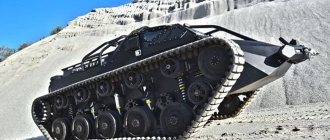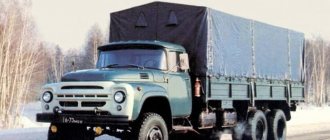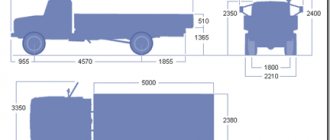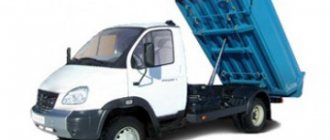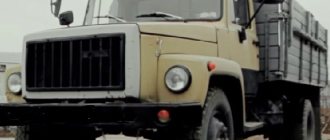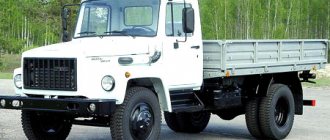and
GAZ-3309
- Soviet and Russian cars in the family of the fourth generation of medium-duty vehicles produced by the Gorky Automobile Plant. The GAZ-3307 flatbed carburetor truck has been in mass production since the end of 1989, and the GAZ-3309 turbodiesel truck has been in production since the end of 1994. The GAZ-3307 replaced the third-generation GAZ-52/53 family, which it completely replaced from the production line by the beginning of 1993. Trucks GAZ-3307 and GAZ-3309 with a load capacity of 4.5 tons are designed for use on all types of paved roads. The fourth family of GAZ trucks also included the 5-ton diesel truck GAZ-4301 (1992-1995) and the 3-ton diesel truck GAZ-3306 (1993-1995). Since 1999, a 2-/2.3-ton off-road truck GAZ-3308 "Sadko" (4x4) with a single tire rear axle and a centralized tire pressure control system has been produced, and since 2005 a 4-ton off-road truck has been produced GAZ-33086 “Countryman” with a dual-pitch rear axle tire.
GAZ-330250-288
GAZ-330250-288
GAZ-330250-288
Until recently, the most popular form of bringing the Gazelle closer to business was the amateur conversion of the car to gas fuel. Prices for such a service reached 30 thousand rubles. It's over now. In an effort to strengthen the position of the Gazelle-Business family in the domestic market, the plant began producing cars that consume both gasoline and propane.
This modification is only 26 thousand more expensive than the gasoline version while maintaining the general warranty on the car. Considering that the Ministry of Transport has come up with a proposal to reduce MTPL tariffs for gas-cylinder vehicles by 15%, this version becomes even more attractive.
Purpose
The main purpose of the GAZ 3307 was and remains the transportation of goods and people over short distances on public roads. The car chassis is used for the installation of various types of bodies and special equipment. In urban environments, the vehicle is in demand in a version with isothermal vans for the delivery of bread, drinks and other food products. The onboard GAZ 3307 with extension sides (often home-made) is widely used on livestock complexes and farms for the delivery and distribution of feed. At industrial enterprises and construction sites, the vehicle in the tipper version was used to transport bulk cargo and construction materials. With the KUNG mounted on the chassis, the GAZ 3307 is still operated by gas and electrical service teams, city water utilities, and emergency vehicle technical support workshops. In the municipal sector, vehicles are converted into garbage trucks, universal street cleaning vehicles, watering tankers, etc. Received the index GAZ-3308 and the name “Sadko”, an all-wheel drive analogue of the rear-wheel drive version, is supplied for the needs of the army.
GAZ-330250-288
Converting the Gazelle to propane is not only a significant increase in the service life of a gasoline engine (gas enters the engine in the vapor phase, so it does not wash away the oil film from the cylinder walls, which extends the service life of the engine; spark plugs also last longer). The main thing is that the total mileage of a dual-fuel car increases: by an additional 400 km, which is very good. In addition, propane is approximately 50% cheaper than A92 gasoline. Here it is, the notorious backup plan “B”, which all decent strategists have. GAZ Group President Bo Anderson is no exception.
The machine uses a fourth generation gas injection system (GIS) from the Italian company OMVL. The choice of an LPG supplier is not accidental - the products of this company are used on the assembly lines of Citroen, Peugeot, Volkswagen and many others. The basis of the gas component is an additional controller that controls the engine when running on propane. In addition, it blocks the operation of gasoline injectors and, based on signals received from the main controller, controls the gas valves. When parked or while running on gasoline, the gas supply, in turn, is shut off by an electromagnetic valve embedded between the cylinder and the evaporator reducer.
Modifications
GAZ 3307 was modified almost throughout its production period. The changes mainly concerned systems serving different types of engines. The main modifications of the car include:
- GAZ-43-01 - experimental version of 1984 with power steering;
- GAZ-33-09 is a car completely unified with the GAZ 3307 in terms of cabin and chassis, with a 116-horsepower turbocharged four-cylinder diesel engine GAZ-5441. It differed from the GAZ 3307 in appearance only by the air intake pipe on the left side of the cabin;
- GAZ-33-08 “Sadko” is an all-wheel drive version with a 4X4 wheel arrangement. In the military version it has a load capacity of 2, in the civilian version 2.3 tons;
- GAZ-33-086 “Countryman” - is equipped with a Minsk diesel engine MMZD-245.7 with a power of 122 hp. An all-wheel drive vehicle with a 4X4 wheel arrangement is equipped as standard with wheels with an inflation system, optics with halogen light sources, and 20-inch rims;
- SAZ-35072 is a dump truck with one-way unloading with a lifting capacity of 4.1 tons. Base - GAZ-33072 chassis.
Dmitry Chakhutin, Yekaterinburg, private entrepreneur
— I purchased a dual-fuel Gazelle in December 2010. Before that, I also had a truck from Nizhny, which I converted to gas myself. However, in order to install the equipment, it was necessary to register changes in the design, and this is tedious, at least in our region. Yes, and it costs money. The mileage on the new car is now only 10,000 km, so far I’m happy with everything.
At the beginning of this year I underwent the first maintenance: all indicators are normal. Gas consumption on the highway is approximately 20 liters per hundred. I drive a car with plastic windows; a full propane charge lasts for 410 km. At the same time, I hardly consume gasoline - only to start the Gazelle. I traveled from Yekaterinburg to Orenburg and back several times - a circle of about 1800 km. Propane gas stations are common on the highway. The price of gas ranges from 10 to 12 rubles. I spent only 3,600 rubles on fuel! You understand, the benefits are obvious. As for urban use, the consumption here is higher, about 22–24 liters.
I have heard many times that a car runs worse on gas than on gasoline. I have traveled through the Ural passes more than once with a full load. So, I can easily get into some of them in fourth or even fifth gear. There are also disadvantages, although not so significant. Let's say the paint has already peeled off from the gas cylinder!
It’s a shame, after all, this is not just “Gazelle”, but “Gazelle-Business”. True, the dealer promised to repaint the cylinder under warranty. I would also fasten the gas filler cap on a chain: when parked, it’s easy to forget it on the pump.
Transmission and brakes
The design of the all-terrain vehicle uses a permanently closed, dry, single-disc damper clutch with a diaphragm pressure spring. Gearbox – mechanical, five-speed, three-way. The same is installed on the all-wheel drive off-road truck GAZ Sadko. Gear ratios: 1st speed: 6.555; 2nd: Z.9ZZ; Z-I: 2,Z76; 4th: 1.442; 5th: 1,O; reverse: 5.7Z5.
Cardan transmission is an open, 2-joint cardan shaft with crosspieces on needle-type bearings. Additional transmission – mechanical, 2-speed, 2-shaft. Gear ratios: O.96 and O.56. The main gear is single-stage, bevel, with spiral teeth. Gear ratio – 1.9.
Multi-disc onboard clutches are dry, with steel discs. There are ten drive disks, 9 driven disks, and fourteen pressure springs.
The service brakes of the snow and swamp-going vehicle are double band brakes, with parallel bands and floating pads. The width of the pad is 62 mm, and the outer diameter of the brake drum is 30 mm. Service brakes and their drive from control levers are used as parking (mountain) brakes. Final drives are single-stage, with spur gears; final drive ratio – 3.7.
The diesel fuel supply is controlled by a pedal and a handle; turning control - turning off the side clutches and braking the drive wheels using 2 control levers
The service brakes are controlled by braking the drive wheels using 2 control levers. The parking (mountain) brake is controlled by fixing the control levers in the braked state with pawls, which are driven by the buttons of the control levers.
HELP ZR
Being the largest oil and gas producing country, Russia has a sufficient resource base to expand the production of liquefied hydrocarbon gases. Associated petroleum gas reserves in Russian oil fields are estimated to be about 1.5 trillion. m3.
GAZ-330250-288: Plan “B”
GAZ Group launched the dual-fuel Gazelle-Business, ready to run on gasoline and propane. , Maxim Prikhodko stepped on the gas . Photo by Konstantin Yakubov and Mikhail Sorokin .
Until recently, the most popular form of bringing the Gazelle closer to business was the amateur conversion of the car to gas fuel. Prices for such a service reached 30 thousand rubles. It's over now. In an effort to strengthen the position of the Gazelle-Business family in the domestic market, the plant began producing cars that consume both gasoline and propane. This modification is only 26 thousand more expensive than the gasoline version while maintaining the general warranty on the car. Considering that the Ministry of Transport has come up with a proposal to reduce MTPL tariffs for gas-cylinder vehicles by 15%, this version becomes even more attractive.
Converting the Gazelle to propane is not only a significant increase in the service life of a gasoline engine (gas enters the engine in the vapor phase, so it does not wash away the oil film from the cylinder walls, which extends the service life of the engine; spark plugs also last longer). The main thing is that the total mileage of a dual-fuel car increases: by an additional 400 km, which is very good. In addition, propane is approximately 50% cheaper than A92 gasoline. Here it is, the notorious backup plan “B”, which all decent strategists have. GAZ Group President Bo Anderson is no exception.
The machine uses a fourth generation gas injection system (GIS) from the Italian company OMVL. The choice of an LPG supplier is not accidental - the products of this company are used on the assembly lines of Citroen, Peugeot, Volkswagen and many others. The basis of the gas component is an additional controller that controls the engine when running on propane. In addition, it blocks the operation of gasoline injectors and, based on signals received from the main controller, controls the gas valves. When parked or while running on gasoline, the gas supply, in turn, is shut off by an electromagnetic valve embedded between the cylinder and the evaporator reducer.
Among the traces of gasification visible from the outside is a hundred-liter red tank with the inscription “Propane”. By the way, it is precisely because of this that dual-fuel gazelles are still available as a truck and van: placing a gas tank on them is easier and more technologically advanced. The engine is switched from gasoline to gas using a fuel type switch (it is located on the instrument panel unsuccessfully, but more on that later). One press of the button - the engine runs on gasoline, the second - switches to gas.
Now about the driving sensations. For the test, I got a manufactured goods van without a hood on the roof of the cab, which some wits still call aerodynamic. I adjusted the seat, started the engine and began to look for the gas switch. When you stand, finding it is not a problem, but while walking, the small plastic square never came across. The fact is that he is practically in the blind spot, although under his right hand. The switch is small, but thanks to the LED indication it is able to tell the driver how much gas is left in stock. You can’t even see her from the driver’s seat! There is only one way out: assign control of the gas level to your partner. As a last resort, check the balance during stops. It’s simply surprising why they didn’t find a more suitable corner on the huge dashboard of the Gazelle Business.
As for the general perception, driving a carbonated Gazelle is practically no different from driving a similar car with traditional fuel. Except that the acceleration dynamics, if category B trucks have any at all, are even more modest than when driving on gasoline. However, this indicator is not paramount for a workhorse. The main thing is to save on fuel. And gas stations, by the way, are almost more common than gasoline at ordinary gas stations.
GAZ-330250-288: Plan “B”
Engine
Over the years, under the hood of the GAZ 3307 there were carburetor and diesel engines with water cooling, as well as diesel engines with atmospheric cooling from domestic and foreign manufacturers. Among the manufacturers are Zavolzhsky Motor Plant, Gorky Automobile Plant, Minsk Motor Plant, Deutz and Cummins. Back in the 80s of the last century, the USSR set a course for dieselization of the truck fleet. Nowadays, the trend continues, and for the most part, manufacturers are switching to modern diesel engines, equipped to meet increasingly stringent environmental standards. The cars of the line are equipped with Minsk D-245.7, which are widely used.
Basic data of the D-245.7 engine
- Type – diesel, in-line, four-cylinder;
- Working volume – 4.75 l;
- Power – from 117 to 130 hp. depending on the configuration;
- Compliance with the latest environmental standards - Euro 4;
- Cylinder block – cast, cast iron;
- The cylinder head is cast iron, parallelepiped-shaped;
- Types of oil filters used - centrifugal, non-separable, with a replaceable filter element;
- Engine weight – from 480 to 530 kg.
Loading platform
Behind the cabin, a cargo platform with folding sides was installed on wooden joists. The folding side boards consisted of four boards, which were bolted together with four metal crossbars and suspended from the platform on four hinges. The tailgate also consisted of four boards, which were bolted together with three metal cross members and suspended from the platform on three hinges. In the closed position, the sides were secured with special locks. A spare wheel was secured under the side platform behind the rear axle, and a towing device for trailers and artillery pieces was also mounted to the last cross member of the frame.
Machine gun and cannon weapons
In peacetime, an extensive set of light weapons from single to quadruple machine guns, as well as cannons of 25 and 37 mm caliber was installed in the side bodies of GAZ-AAA trucks, as well as GAZ-AA, without any special modifications. Next to them were boxes of ammunition and places for combat crews. By the beginning of the war, the Red Army had over two thousand of these vehicles in service, but in real battles they turned out to be ineffective.
A regular GAZ-AAA truck with a coaxial machine gun at a parade in Mongolia
Cars with quadruple 4M Tokarev machine guns at a parade in Kyiv
25 mm anti-aircraft gun in a GAZ-AAA body with folded sides
Self-propelled artillery unit SU-12 at the parade on Red Square (film shot)
The SU-12 self-propelled artillery mount with a 76.2 mm regimental gun and frontal armor shield was mounted on a semi-armored three-axle chassis. The poor maneuverability and vulnerability of these systems forced them to abandon their combat use.
Specifications
The GAZ 51 two-axle rear-wheel drive truck was capable of reaching a maximum speed of 70 km/h.
Engine
At the end of the 1930s, the Gorky Automobile Plant launched production of the in-line GAZ-11 engine, which was initially a licensed version of the engine from the American company Dodge. The engine was very technologically advanced, and no non-ferrous metals were used for the manufacture of its parts, with the exception of the pistons. Significantly improved during the war years, this power unit was used for a long time on various vehicles, including buses, special vehicles and tractors, and was produced in the USSR until 1989.
The engine had 6 cylinders, its displacement was 3485 cc. The engine power of 70 horsepower was not the maximum and was restrained by the crankshaft speed limiter, the maximum operating value of which was allowed at 2800 rpm. This added endurance and reliability to the engine, which did not tolerate prolonged increased loads well, which was complicated by the large gear ratio of the main rear axle pair.
Suspension and transmission
The GAZ-51 suspension was considered quite progressive even by modern standards. It consisted of 4 longitudinal semi-elliptic springs and 2 springs related to the rear axle. The suspension also used lever-type hydraulic shock absorbers, which were replaced by telescopic elements in the late 1960s. The suspension of the currently produced Lawn Next truck has a similar design. The permissible load on the front axle was 1610 kg, on the rear axle - 3760 kg.
The GAZ-51 transmission consisted of a manual 4-speed gearbox without synchronizers, a single-plate dry clutch and a single-stage final drive.
Rear axle and chassis
In the truck chassis, a rigid front axle ensured maximum stability. The rear axle had a single final drive and was assembled inside a beam, complete with a split housing. This design was considered very perfect, and was later almost completely repeated on the three-axle ZiS-151 truck. The rear axle of the GAZ-51 was driving.


